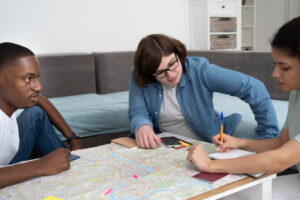Earthquakes are sudden and often unpredictable, and while they can be frightening, being prepared can make a big difference in staying safe. Knowing what to do before, during, and after an earthquake can help protect kids and reduce the risk of injury. This guide outlines the top 10 earthquake safety measures for kids, designed to be easy to remember and follow, plus tips for families, schools, and caregivers to ensure everyone is ready when an earthquake strikes.
1. Know Your Safe Spots at Home and School
What are Safe Spots?
Safe spots are secure areas in each room that offer the best protection from falling objects or collapsing structures. These spots are usually under sturdy tables or against inner walls away from windows.
How to Identify Them:
With a parent or teacher’s help, kids can walk through each room in the house or classroom to identify safe spots. At home, this might include tables in the living room or dining room, while at school, teachers often identify these places in the classroom ahead of time. It’s important to avoid places with large, unsecured objects, such as tall bookshelves or heavy appliances.
Practice Makes Perfect:
Familiarity with these spots helps kids respond quickly during an earthquake, reducing the risk of freezing or panicking. Practicing these steps as a family or with classmates makes it second nature to take cover in these areas when needed.
2. Learn the “Drop, Cover, and Hold On” Technique
What is Drop, Cover, and Hold On?
This technique involves three key steps that protect against falling objects and injuries:
- Drop: Get down on your hands and knees to prevent being knocked over.
- Cover: Shield your head and neck, ideally under a sturdy table, and move close to your safe spot.
- Hold On: Hold on to the table or surface to stay steady until the shaking stops.
Why This Technique Works:
Staying low prevents falls and helps avoid more dangerous flying or falling objects. Shielding your head is critical, as head and neck injuries are common in earthquakes. Practicing this technique as part of school and home drills can help reinforce these motions so that kids instinctively follow them when an earthquake begins.
3. Stay Away from Windows, Mirrors, and Glass
Understanding the Dangers:
Windows and mirrors can shatter during an earthquake, creating sharp flying glass that can cause serious injuries. Glass tables, picture frames, and other glass objects should also be avoided.
How to Stay Safe:
Kids should avoid sitting or playing near windows or glass whenever possible. In the event of an earthquake, they should move away from these surfaces and find an inner wall or table to hide under, away from potential falling glass.
Practical Tip for Families:
Parents can help reinforce this by arranging rooms so that play areas are away from windows, large mirrors, or unsecured glass items.
4. Secure Heavy Furniture and Objects at Home
Why Securing Furniture is Important:
Heavy items, such as bookshelves, dressers, and appliances, can easily tip over during an earthquake. Securing these items prevents them from falling, reducing the risk of injury to anyone nearby.
How to Secure Furniture:
Use brackets, straps, or furniture anchors to attach heavy items to the wall. Parents should avoid placing heavy objects like books or pots on high shelves, as these can fall and cause injury.
Teaching Kids to Stay Clear of Large Objects:
Encourage kids to stay away from large pieces of furniture during an earthquake and not to climb on shelves or dressers at any time.
5. Practice Earthquake Drills Regularly
The Importance of Drills:
Regular practice helps kids remember and apply safety steps without hesitation. Earthquake drills are a standard part of safety practices in schools and should also be practiced at home.
How to Conduct a Drill at Home:
Set up monthly or quarterly drills with family members. During each drill, practice “Drop, Cover, and Hold On” and review the family meeting spot. Make it engaging by timing the drill and rewarding participation to keep everyone motivated.
School Drill Tips:
Teachers can incorporate storytelling or play activities into drills for younger kids to help them engage with the process without feeling scared.
6. Have an Emergency Plan with Your Family
Why an Emergency Plan Matters:
An emergency plan ensures every family member knows what to do and where to go after an earthquake. This helps prevent panic and makes it easier to account for everyone after an emergency.
Creating a Plan:
Decide on a family meeting spot outside the house where everyone can gather after an earthquake. This might be in the front yard, a nearby park, or another safe location.
Practice the Plan Together:
Practicing the emergency plan as a family ensures everyone remembers where to go and what to do if they’re separated during or after an earthquake.
7. Keep Emergency Supplies Ready
What Should an Emergency Kit Include?
A basic emergency kit should contain:
- Bottled water and non-perishable snacks
- A flashlight with extra batteries
- A first-aid kit with bandages, antiseptic, and any needed medications
- Basic personal hygiene items and extra masks if available
- Emergency contact information
Involving Kids in Kit Preparation:
Allow kids to help prepare the emergency kit by choosing their favorite snacks, packing a small toy, or learning about each item’s purpose. This gives them a sense of control and teaches them the importance of emergency preparedness.
Knowing Where the Kit Is Located:
Make sure the emergency kit is stored in a place that’s easy to reach. Kids should know where it’s kept and be able to access it if needed.
8. Stay Indoors During an Earthquake
Why Staying Indoors is Safer:
Running outside during an earthquake can increase the risk of injury from falling objects, collapsing walls, or broken glass. In most cases, it’s safer to stay indoors, drop to the ground, and take cover until the shaking stops.
Where to Take Cover Indoors:
Kids should find a safe spot under a sturdy table or against an inner wall, away from windows and heavy furniture. Holding on to a steady surface will also help them stay balanced as the ground shakes.
Teaching Kids to Remain Calm and Still:
Remind kids not to run around or leave their safe spot until the shaking completely stops. Practicing staying calm and steady during drills can help them avoid unnecessary risks in a real earthquake.
9. Stay Calm and Don’t Panic
The Role of Calmness in Safety:
Panic can lead to accidents and mistakes during an earthquake. Kids should be encouraged to stay calm, take deep breaths, and focus on the steps they’ve practiced.
How to Stay Calm:
Breathing exercises or visualizing safe actions can help. In stressful moments, focusing on familiar steps like “Drop, Cover, and Hold On” will keep them grounded.
Reassurance from Adults Helps:
During drills, adults can practice calm, reassuring language to help kids feel safe and in control. This can make a big difference in how they handle the situation during an actual earthquake.
10. Know What to Do After the Earthquake Stops
Assessing Safety Before Moving:
Once the shaking stops, kids should look around to check for hazards like broken glass, fallen objects, or exposed electrical wires. If it’s safe, they should exit the building calmly and meet family or classmates at the agreed-upon meeting spot.
Following Instructions at School:
In a school setting, kids should listen to their teacher and follow the school’s evacuation plan. This may include waiting in a designated outdoor area until it’s deemed safe to go back inside or leave for home.
Reuniting with Family:
If at home, kids should head to the family’s emergency meeting spot. Waiting here is essential, as it helps families account for everyone’s safety without unnecessary confusion.
Conclusion:
Earthquake safety is all about preparedness, practice, and staying calm. By following these ten steps, kids can develop the confidence and skills to protect themselves during an earthquake, reducing the risk of injury and ensuring they know how to react in a sudden emergency. Practicing safety measures at home and school, along with regular drills and family planning, helps create a foundation of safety and readiness. Earthquakes may be unpredictable, but having a clear plan and knowing what to do can make a big difference in keeping everyone safe. Parents, teachers, and caregivers all play vital roles in reinforcing these safety habits, empowering kids to handle earthquakes with composure and resilience.
FAQs
If you’re outside when an earthquake starts, move away from buildings, trees, streetlights, and power lines, as these can fall or break. Find an open area and sit down on the ground, covering your head and neck with your arms to protect yourself. Stay in that position until the shaking stops.
You can help by reminding your family to have an emergency kit ready with essentials like water, snacks, a flashlight, and first-aid supplies. Practice earthquake drills together, identify safe spots in your home, and make a family emergency plan, including a designated meeting spot outside.
If an earthquake happens at school, follow the “Drop, Cover, and Hold On” steps. Listen to your teacher’s instructions, as they are trained to keep you safe. After the shaking stops, stay calm and follow your teacher to the designated safe area outside, where you’ll wait until it’s safe to return or go home.





